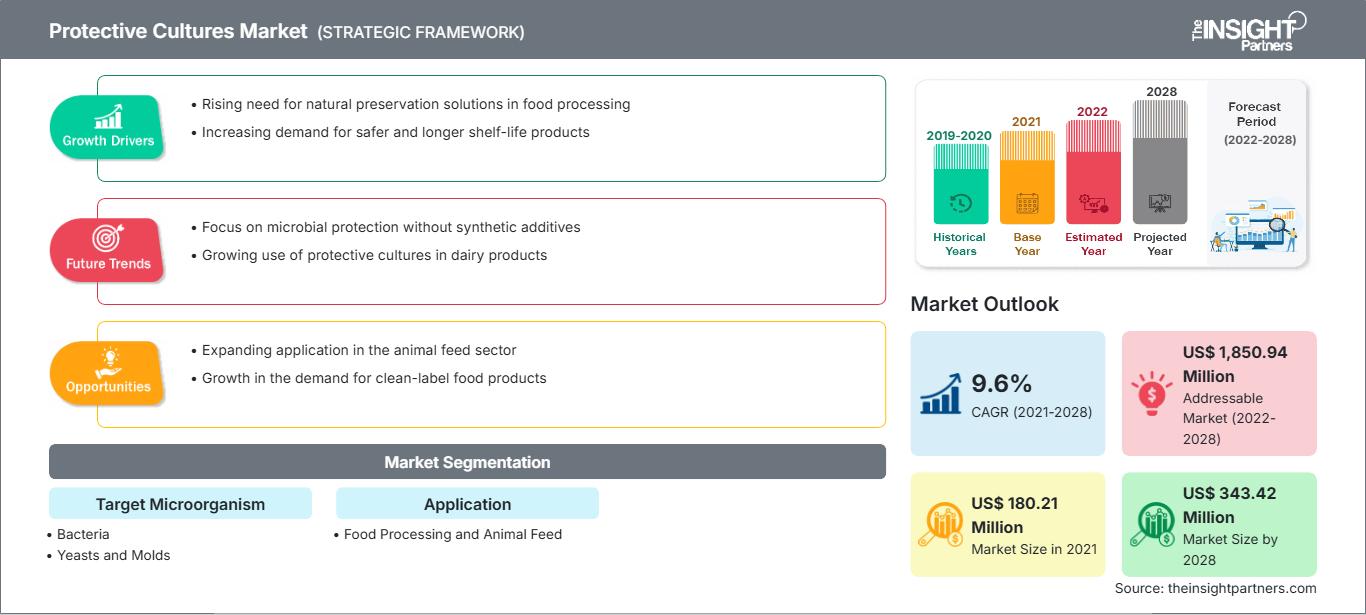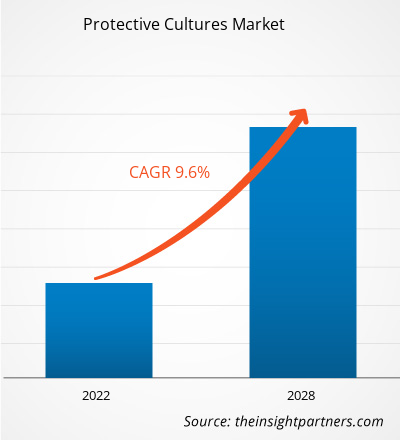[Research Report] The protective cultures market is expected to grow from US$ 180.21 million in 2021 to US$ 343.42 million by 2028; it is estimated to grow at a CAGR of 9.6% from 2021 to 2028.
Increasing demand for natural and chemical preservative-free products and growing demand for perishable products with extended shelf life across the world drive the growth of the protective cultures market.
The protective cultures market in Asia Pacific is expected to grow at the highest CAGR during the forecast period. China is the most important dairy product market and is mainly driven by the increasing consumption of dairy products. The growing demand for dairy products such as natural snacks, fermented dairy products such as sour milk, and yogurt coupled with product and packaging innovations is driving the growth of the dairy product market in Asia-Pacific. Therefore, the protective cultures market is expected to witness significant growth in the coming years owing to the increasing consumption of dairy products and the benefits of protective cultures, such as the ability to inhibit the growth of pathogenic and spoilage microorganisms. Moreover, increasing awareness about natural and clean label products amongst the Asian population is subsequently aiding the market expansion.
Customize This Report To Suit Your Requirement
You will get customization on any report - free of charge - including parts of this report, or country-level analysis, Excel Data pack, as well as avail great offers and discounts for start-ups & universities
Protective Cultures Market: Strategic Insights

-
Get Top Key Market Trends of this report.This FREE sample will include data analysis, ranging from market trends to estimates and forecasts.
Impact of COVID-19 Pandemic on Protective Cultures Market
The ongoing COVID-19 pandemic has had a relatively positive impact on the protective cultures market. The pandemic helped to develop an interest and awareness related to the microbial cultures. The crisis has been a disagreeable and a stressful time for most of the population across the world. Therefore, the people across the world have started consuming clean label products. After the advent of the COVID-19 pandemic, people have become more cautious regarding food and are consuming healthier food than usual diet. The COVID-19 pandemic has changed the consumer’s perception of clean beyond labels or products. Consumers continue to maintain their focus on clean label for at-home as well as out-of-home purchases, which is increasing the application of clean label in the various food applications. Moreover, the outlook for economic progress across most countries is optimistic for 2021.
Market Insights
Increasing Consumption of Dairy Products
The dairy market is evolving across the world. Consumers prefer better-for-you, natural, and sustainable dairy products with shorter ingredient lists and better transparency on product labeling. With the growing busy modern lifestyles, there is an increasing demand for convenient options that can be consumed on the go without having to be refrigerated to stay fresh. Protective cultures are significant in supporting dairy manufacturers to add to their bottom line by avoiding spoilage throughout shelf life, thereby meeting the consumer needs for natural and clean label products. Moreover, the consumption of dairy products, such as yogurt, butter, and cheese, is surging across the globe.
Cheese has become a primary component in daily diets worldwide. According to the United States Department of Agriculture, 5,733 metric tonnes of cheese was produced in the country in 2017, and people in North America on an average consume ~6,626 metric tonnes of cheese annually. The cheese market is also one of the major end users of protective cultures due to specific protective culture used against Listeria. It is made from Lactobacillus plantarum and is effective in preventing Listeria from forming on the high-risk red smear surface-ripened cheeses. Henceforth, these aforementioned factors drive the demand for cheese in protective cultures market. Furthermore, companies such as DuPont Danisco and Chr Hansen have a significant presence in the dairy products market with extensive dairy protective cultures. With rising demand for natural and healthy dairy products, clean-label and green-label products are witnessing huge demand in the dairy industry.
Target Microorganism Insights
Based on target microorganism, the protective cultures market is bifurcated into bacteria, and yeast and molds. The yeast and molds segment accounted for a larger market share in 2020. Yeasts are a subset of fungi, a large group of organisms that also includes molds and mushrooms. They are typically single-celled organisms that have evolved to live in specialized environment. Yeast typically colonizes on high-salt or high-sugar foods, such as pickles, maple syrup, and others, which contribute to their deterioration. Fruits and liquids with a low pH are other targets, and there are some yeasts that develop on the surfaces of meat and cheese. Molds are made up of millions of microscopic cells that are linked together to create chains and can be found on bread, fruit, damp paper, and other surfaces. They can spoil dry foods, salted fish, fruits, jellies, bread, pickles, jams, and other similar products.
Application Insights
Based on application, the protective cultures market is bifurcated into food processing and animal feed. The food processing segment accounted for a larger market share in 2020, whereas the animal feed segment is expected to register a higher CAGR in the market during the forecast period. Food processing comprises various industries such as dairy products; beverages; and meat, poultry, and seafood products. There is an increasing use of protective cultures, especially in the dairy, meat, and seafood industries, as they are generally recognized as safe (GRAS) for consumption and naturally predominate in the microbiota of many foods. In addition, due to the need for products with a longer shelf life, food processors are increasingly using protective cultures. Additionally, consumers are becoming aware that a large amount of food waste is caused because of spoilage and mold growth. This also affects the profitability of food processors; thus, processors use protective cultures to reduce food waste. Therefore, the demand for these products is increasing in the food industry. Protective cultures are crucial in helping dairy producers to improve their products by avoiding spoilage throughout the shelf life, extending the shelf life while meeting consumer demand for natural and cleaner products.
A few players operating in the protective cultures market are Biochem Srl, Bioprox, Chr. Hansen Holding A/S, Meat Cracks Technologie GmbH, DSM, Lallemand Inc., International Flavors & Fragrances Inc., Kerry Group, Sacco System, and Dalton Biotechnologies S.r.l. The key companies adopt strategies such as the mergers and acquisitions, and research and development to expand customer base and gain significant share in the global market, which also allows them to maintain their brand name globally.
Protective Cultures Market Regional InsightsThe regional trends and factors influencing the Protective Cultures Market throughout the forecast period have been thoroughly explained by the analysts at The Insight Partners. This section also discusses Protective Cultures Market segments and geography across North America, Europe, Asia Pacific, Middle East and Africa, and South and Central America.
Protective Cultures Market Report Scope
| Report Attribute | Details |
|---|---|
| Market size in 2021 | US$ 180.21 Million |
| Market Size by 2028 | US$ 343.42 Million |
| Global CAGR (2021 - 2028) | 9.6% |
| Historical Data | 2019-2020 |
| Forecast period | 2022-2028 |
| Segments Covered |
By Target Microorganism
|
| Regions and Countries Covered |
North America
|
| Market leaders and key company profiles |
|
Protective Cultures Market Players Density: Understanding Its Impact on Business Dynamics
The Protective Cultures Market is growing rapidly, driven by increasing end-user demand due to factors such as evolving consumer preferences, technological advancements, and greater awareness of the product's benefits. As demand rises, businesses are expanding their offerings, innovating to meet consumer needs, and capitalizing on emerging trends, which further fuels market growth.

- Get the Protective Cultures Market top key players overview
Report Spotlights
- Progressive industry trends in the protective cultures market to help players develop effective long-term strategies
- Business growth strategies adopted by developed and developing markets
- Quantitative analysis of the protective cultures market from 2019 to 2028
- Estimation of global demand for protective culture
- Porter’s Five Forces analysis
- Recent developments to understand the competitive market scenario
- Market trends and outlook as well as factors driving and restraining the growth of the protective cultures market
- Assistance in decision-making process by highlighting market strategies that underpin commercial interest, leading to the market growth
- The size of the protective cultures market size at various nodes
- Detailed overview and segmentation of the market, as well as the protective culture industry dynamics
- Size of the protective cultures market in various regions with promising growth opportunities
Protective Cultures Market – by Target Microorganism
- Bacteria
- Yeast and Mold
Protective Cultures Market – by Application
- Food Processing
- Dairy Products
- Beverages
- Meat, Poultry, and Seafood Products
- Others
- Animal Feed
Company Profiles
- Biochem Srl
- Bioprox
- Chr. Hansen Holding A/S
- Meat Cracks Technologie GmbH
- DSM
- Lallemand Inc.
- International Flavors & Fragrances Inc.
- Kerry Group
- Sacco System
- Dalton Biotechnologies S.r.l
Frequently Asked Questions
Based on application, which segment is leading the global protective cultures market during the forecast period?
How is the competitive rivalry in the global protective cultures market?
Which major factors are influencing the growth of global protective cultures market?
Which region held the largest share of the global protective cultures market?
Can you list some of the major players operating in the global protective cultures market?
Based on target microorganism, which segment led the global protective cultures market in 2020?
- Historical Analysis (2 Years), Base Year, Forecast (7 Years) with CAGR
- PEST and SWOT Analysis
- Market Size Value / Volume - Global, Regional, Country
- Industry and Competitive Landscape
- Excel Dataset
Recent Reports
Testimonials
Reason to Buy
- Informed Decision-Making
- Understanding Market Dynamics
- Competitive Analysis
- Identifying Emerging Markets
- Customer Insights
- Market Forecasts
- Risk Mitigation
- Boosting Operational Efficiency
- Strategic Planning
- Investment Justification
- Tracking Industry Innovations
- Aligning with Regulatory Trends





















 Get Free Sample For
Get Free Sample For